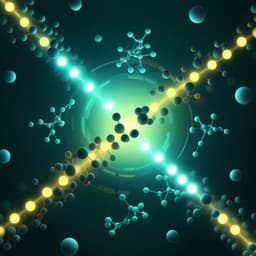
Engineering and Technology
Bias-free solar hydrogen production at 19.8 mA cm⁻² using perovskite photocathode and lignocellulosic biomass
Y. Choi, R. Mehrotra, et al.
This groundbreaking research led by Yuri Choi and colleagues unveils a photoelectrochemical cell that achieves an impressive photocurrent density of 19.8 mA cm⁻² for hydrogen production, utilizing organic-inorganic halide perovskite and lignocellulosic biomass. The process not only enhances solar hydrogen productivity but also converts lignin into valuable chemicals, showcasing an innovative approach to sustainable energy.
~3 min • Beginner • English
Introduction
Solar hydrogen production is considered a key route to harness intermittent solar energy, but remains challenging due to the sluggish four-electron water oxidation reaction requiring high overpotentials (>300 mV; >1.5 V vs RHE at 10 mA cm−2) and complications from O2 generation, separation, and safety. Biomass oxidation offers a lower-potential electron source with potential economic value from oxidation byproducts, but prior use of processed, edible biomass raises ethical and economic concerns. Lignocellulosic (LC) biomass is abundant and practical but is difficult to use directly due to low solubility and molecular complexity, leading to low conversion and poor selectivity. Conventional inorganic photocatalysts (e.g., TiO2, WO3, BiVO4) have large bandgaps (2.4–3.2 eV) and poor optoelectronic properties, limiting solar flux utilization and often requiring external bias. Lead halide perovskites offer tunable bandgaps, high absorption coefficients, and excellent charge transport, but few perovskite-based photoelectrodes for solar H2 have been reported and none with biomass oxidation due to perovskite moisture sensitivity. The study aims to realize bias-free solar H2 production by combining a perovskite photocathode with LC biomass oxidation mediated by phosphomolybdic acid (PMA), enabling lower anodic potentials, eliminating O2 evolution, and co-producing value-added chemicals through selective lignin depolymerization.
Literature Review
Prior work established that water oxidation is the kinetic bottleneck for solar hydrogen production, demanding high overpotentials even with Ir/Ru catalysts and complicating systems with O2 evolution. Alternatives to water as the electron source have included biomass-derived molecules (e.g., glucose, alcohols), but these often rely on highly processed edible feedstocks, raising food ethics and cost concerns. Strong oxidants such as PMA5+ and Fe3+ have been used to oxidatively depolymerize biomass and act as mediators in electrochemical devices, typically at elevated temperatures with extensive depolymerization and CO2 emissions. Conventional inorganic photoelectrodes (TiO2, WO3, BiVO4) offer stability and low cost but suffer from large bandgaps and poor charge transport, limiting STH efficiency below commercialization benchmarks (~10%). Lead halide perovskites provide superior optoelectronic properties and tunable bandgaps, and have been explored in a limited number of photoelectrochemical hydrogen production studies; integration with biomass oxidation has not been reported due to perovskite water vulnerability. This work builds on these insights by employing PMA as a soluble redox mediator to selectively oxidize lignin in LC biomass at low temperatures while coupling a protected perovskite photocathode for efficient, bias-free hydrogen evolution.
Methodology
- Electron mediator and biomass oxidation: PMA (H4PMo12O40) was dissolved at 0.25 M in 10 mL of 0.5 M H2SO4. After sonication (10 min), 0.375 g of lignin, hemicellulose, cellulose, or LC biomass (oak) was added and incubated at constant temperatures (typically 60 °C for 8 h; also 25, 50, 60, 70, 90 °C explored). PMA reduction (color change yellow to dark green) was quantified by UV/Vis (absorbance at 700 nm) and Beer-Lambert to determine fraction reduced (fred). Electrons extracted were calculated as: moles e− per g biomass = n × CPMA × VPMA × fred / Mbiomass (n = 2 for PMA3− → PMA5−).
- Kinetics: Activation energies (Ea) for PMA reduction by each biomass were determined via Arrhenius analysis from temperature-dependent rates: ln(k) = −Ea/(RT) + ln(A).
- Product analysis: After PMA oxidation of biomass at 60 °C, mixtures were filtered; aromatics were extracted with chloroform (1:1 v/v), with n-decane as internal standard, and analyzed by GC-MS to quantify vanillin and acetovanillone. Insoluble/soluble fractions were characterized by FTIR (ATR), 2D 13C–1H HSQC NMR, HPLC (for sugars), GC (headspace for CO/CO2), and Klason method for lignin content. SEM examined microstructural changes post-delignification.
- Electrochemistry of mediator: LSV and chronoamperometry using catalyst-free CNT paper anodes assessed re-oxidation of reduced PMA under acidic conditions (0.5 M H2SO4), benchmarking potentials vs RHE and sensitivity to O2.
- Photocathode fabrication: A low-bandgap perovskite Cs0.05(FA0.83MA0.17)0.95(Pb0.83Br0.17)3 (CSFAMA, Eg ≈ 1.61 eV) served as absorber. To enhance electrical contact and moisture/acid stability, Field’s metal (FM) and a Ti foil (0.25 mm) were integrated; Ti was decorated with ~20 nm Pt nanoparticles as HER cocatalyst. Photocathode stacks included FM/perovskite, Ti/FM/perovskite, and Pt–Ti/FM/perovskite; passivation by FM and Ti improved stability in acid.
- Photoelectrochemical testing: Half-cell HER performance in 0.5 M H2SO4 (pH ~0.65) under simulated AM 1.5G (100 mW cm−2) was evaluated by LSV to determine onset potentials and by stability tests. Optical properties were monitored (UV/Vis, PL). UPS, SEM/TEM/EDS, and ICP analyses characterized materials and Pt stability.
- Bias-free PEC assembly: A two-compartment cell separated by Nafion coupled a perovskite-based photocathode (immersed in 0.5 M H2SO4) and a CNT paper anode in 0.5 M H2SO4 containing pre-reduced PMA. Theoretical operating point was estimated from the intersection of photocathode LSV under light (HER) and anode LSV in dark (PMA re-oxidation). Under AM 1.5G, short-circuit photocurrent, Faradaic efficiency (H2 quantification), IPCE spectrum, and long-term stability (>20 h) were measured. PMA redox integrity was verified by cyclic voltammetry pre/post operation.
Key Findings
- Record bias-free photocurrent density: 19.8 mA cm−2 under AM 1.5G with a single photocathode, corresponding to hydrogen production rate of 512 μmol h−1 cm−2 and STH efficiency of 12.3% (using Vth = 0.62 V for the PMA-assisted process). Near-unity Faradaic efficiency for H2.
- Theoretical performance: Estimated maximum j ≈ 20.4 mA cm−2 at ~0.44 V vs RHE from intersecting LSVs of photocathode (light) and PMA anode (dark).
- Photocathode performance: Onset potentials for HER were 0.49 V (FM/perovskite), 0.62 V (Ti/FM/perovskite), and 1.14 V vs RHE (Pt–Ti/FM/perovskite). Passivation with FM and Ti markedly improved acid stability; Ti/FM and Pt–Ti/FM remained stable >3 h in half-cell tests, while unencapsulated perovskite degraded within minutes.
- Long-term stability: In the full PEC device, continuous operation >20 h retained ~97% of the maximum photocurrent despite consumption/reoxidation cycling of PMA. Slight degradation attributed to perovskite ion migration and partial Pt stripping/corrosion.
- Mediator anodic kinetics: Reduced PMA enabled high anodic currents at low potentials without O2 evolution; current densities of −30 mA cm−2 (LC biomass-derived PMA) and −37 mA cm−2 (lignin-derived PMA) at 0.8 V vs RHE using catalyst-free CNT anodes. Non-reacted PMA or raw biomass alone yielded negligible current.
- Selective lignin depolymerization: At 60 °C, PMA extracted 7.9 and 6.9 mmol e− g−1 from lignin and LC biomass after 8 h; cellulose/hemicellulose required ≥90 °C to react appreciably. Activation energies for PMA reduction (kJ mol−1): lignin 24, hemicellulose 79, cellulose 102, LC biomass 47.
- Valorization products: From 1 g LC biomass, 34.1 mg vanillin and 44.3 mg acetovanillone were produced; lignin alone yielded 43.6 mg vanillin. Approximately 50.6% of original lignin in LC biomass was depolymerized; ~65% of depolymerized lignin (78.4 mg out of 120 mg) converted to vanillin/acetovanillone. Minimal CO/CO2 at 60 °C; significant emissions at 90 °C.
- Mechanistic insights: PMA reduction competes with oxygen reduction; O2 supply suppresses PMA reduction by biomass, while O2 presence does not hinder PMA re-oxidation at the anode. Structural analyses (FTIR, 2D HSQC NMR, SEM) showed preferential lignin cleavage (e.g., β–O–4 linkages), with cellulose/hemicellulose largely intact and generation of hierarchical porosity in LC biomass.
Discussion
The study demonstrates that coupling a protected, low-bandgap perovskite photocathode with a PMA-mediated lignocellulosic biomass oxidation anode enables efficient, bias-free solar hydrogen production while avoiding the kinetic and practical drawbacks of water oxidation. By lowering the anodic potential requirement (<0.8 V vs RHE) through mediator re-oxidation, the system eliminates O2 evolution at the anode, simplifying gas management and improving safety. Simultaneously, selective depolymerization of lignin yields value-added aromatics (vanillin, acetovanillone) while preserving cellulose/hemicellulose for further utilization, enhancing overall process economics and aligning with biorefinery objectives. The perovskite photocathode’s panchromatic absorption and excellent charge transport deliver high photocurrent density (19.8 mA cm−2) and record hydrogen productivity with near-unity Faradaic efficiency. Stability improvements via FM and Ti passivation, along with Pt catalysis, allowed continuous operation for over 20 h with minimal performance loss. These results surpass prior single-photoelectrode PEC and PV-assisted systems and indicate a practical route to integrate renewable hydrogen production with biomass valorization. The findings suggest new design paradigms for PEC systems leveraging soluble redox mediators to decouple anodic substrate oxidation from OER, making use of abundant LC biomass under mild conditions.
Conclusion
This work introduces a bias-free PEC system that achieves a record photocurrent density of 19.8 mA cm−2 and 12.3% STH efficiency by combining a perovskite photocathode with PMA-mediated oxidation of lignocellulosic biomass. The approach simultaneously produces hydrogen and value-added chemicals via selective lignin depolymerization while preserving cellulose and hemicellulose. Device stability over 20 h demonstrates the effectiveness of FM and Ti passivation and Pt catalysis in acidic environments. Future research should focus on: scaling and continuous-flow reactor designs; improving long-term durability of perovskite electrodes (moisture/ion-migration mitigation, robust catalysts and encapsulation); exploring alternative, earth-abundant cocatalysts and mediators with optimized redox potentials; broadening biomass feedstocks and optimizing selectivity/yields for target chemicals; integrating mediator regeneration in day/night cycles and coupling with industrial biorefinery processes for efficient delignification and fractionation.
Limitations
- Durability: Although stable for >20 h, slight performance degradation occurred, likely from perovskite ion migration/accumulation and partial Pt nanoparticle stripping/corrosion; long-term (>1000 h) stability remains unproven.
- Materials sensitivity: Perovskite vulnerability to moisture necessitates robust passivation/encapsulation; acidic operation may constrain material choices and component lifetimes.
- Process conditions: Biomass oxidation requires elevated temperature (e.g., 60 °C for 8–12 h); higher temperatures increase CO/CO2 emissions and reduce selectivity. Oxygen must be limited during PMA reduction to avoid competing ORR.
- Mediator management: PMA acts as a soluble mediator and must be cycled/reduced by biomass between operation periods; system complexity includes mediator handling and potential crossover.
- Feedstock utilization: Lignin is selectively depolymerized while cellulose/hemicellulose remain largely intact; full energy extraction from biomass is not achieved, though this is advantageous for valorization of remaining fractions.
Related Publications
Explore these studies to deepen your understanding of the subject.







